By Leen Randell
Updated: Jul 04, 2024
10 Best Herbal Decoctions For Neck Pain
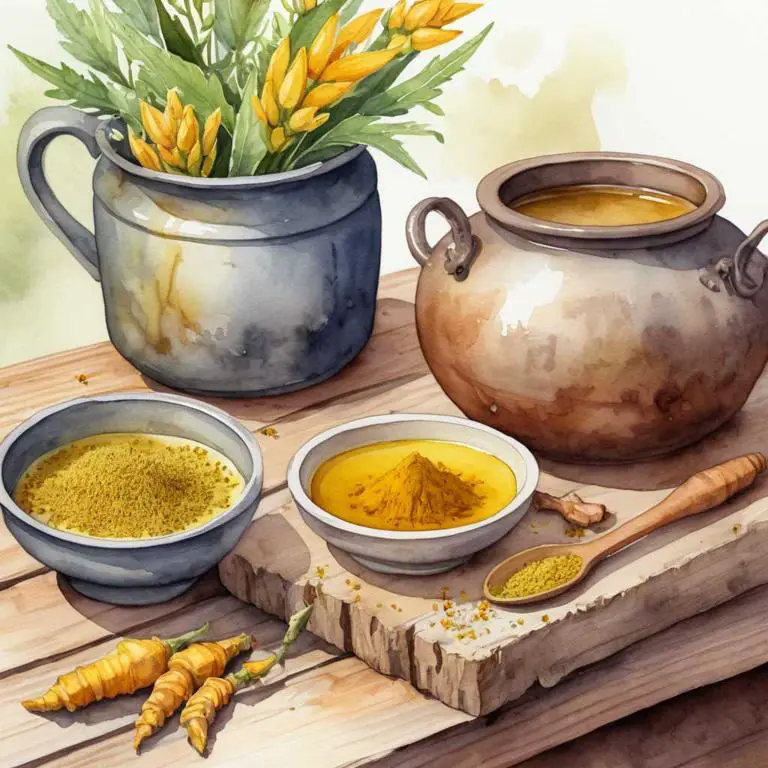
Herbal decoctions for neck pain are a natural remedy that combines herbs, roots, and leaves to create a soothing liquid extract that alleviates discomfort and stiffness in the neck.
By infusing these herbal ingredients in hot water, their active compounds are released, providing anti-inflammatory and relaxing properties that ease tension and promote healing. Examples of herbal decoctions for neck pain include chamomile, lavender, and ginger, which can be consumed as a warm tea or applied topically as a compress.
This natural remedy helps improve lives by reducing chronic pain, improving range of motion, and promoting overall well-being.
The following article describes in detail the most important decoctions for neck pain, including medicinal properties, parts of herbs to use, and recipes for preparations.
- 1. Valeriana officinalis
- 2. Glycyrrhiza glabra
- 3. Cannabis sativa
- 4. Arctium lappa
- 5. Curcuma longa
- 6. Zingiber officinale
- 7. Angelica archangelica
- 8. Capsicum annuum
- 9. Peucedanum ostruthium
- 10. Artemisia absinthium
- What is the best combination of herbal decoctions to use for neck pain?
- What ailments similar to neck pain are treated with herbal decoctions?
1. Valeriana officinalis
Valerian decoctions helps with neck pain because of its unique combination of properties.
The active compounds in valerian, such as valepotriates and isovaleric acid, have a sedative effect on the nervous system, which can help to relax tense muscles and reduce muscle spasms that contribute to neck pain.
Additionally, valerian has anti-inflammatory properties, which can help to reduce swelling and irritation in the neck and shoulder area, providing relief from chronic or acute pain.
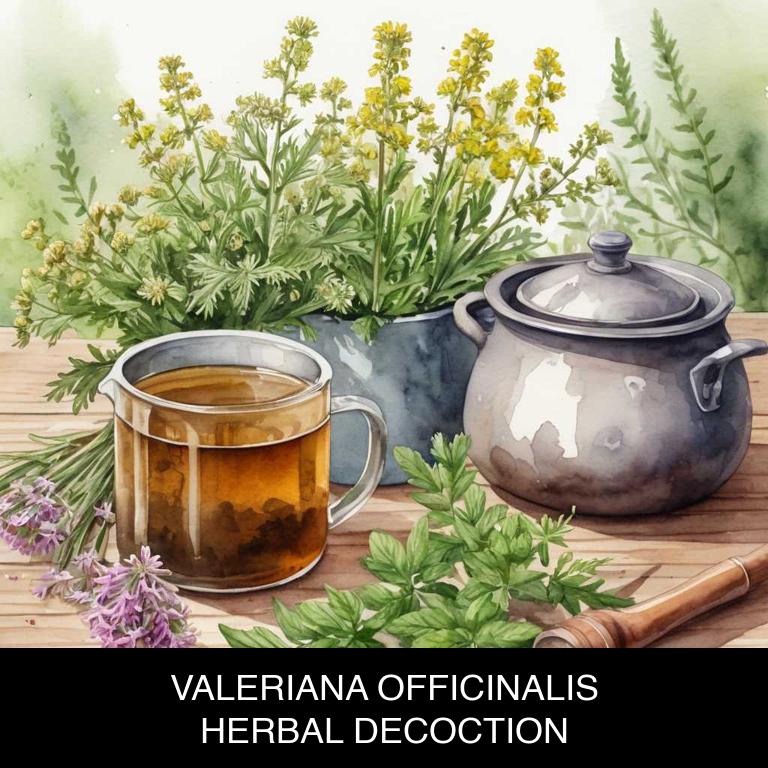
Medicinal Constituents
The list below shows the primary medicinal constituents in Valeriana officinalis decoctions that help with neck pain.
- Valerenic acid: This sesquiterpene helps with neck pain by inhibiting the activity of glutamate receptors, which are involved in pain transmission.
- Valerenal: This sesquiterpene acts as a GABA receptor agonist, which can help reduce muscle spasms and anxiety that may contribute to neck pain.
- Valeranone: This sesquiterpene has analgesic and anti-inflammatory properties, which can help alleviate neck pain by reducing inflammation and pain sensitivity.
Parts Used
The list below shows the primary parts of valerian used to make decoctions for neck pain.
- Roots: Valeriana officinalis roots are the most commonly used part for making decoctions due to their high concentration of valerenic acid, a compound known for its analgesic and anti-inflammatory properties.
- Seeds: Valeriana officinalis seeds are another part used in decoctions for neck pain relief, as they contain alkaloids and esters that contribute to their analgesic and sedative effects.
- Leaves: Valeriana officinalis leaves are sometimes used in decoctions for neck pain, as they are believed to have anti-inflammatory and relaxing properties that can help alleviate tension and discomfort.
Quick Recipe
The following recipe gives a procedure to make a basic valerian for neck pain.
- Harvest 2-3 ounces of fresh valeriana officinalis roots or 1 ounce of dried roots for decoction.
- Wash the roots gently with cold water to remove dirt and impurities.
- Chop the roots into small pieces to increase their surface area for better extraction.
- Combine the chopped roots with 1 quart of boiling water in a saucepan.
- Simmer the mixture for 5-10 minutes or until the liquid has reduced to half its original volume.
2. Glycyrrhiza glabra
Licorice decoctions helps with neck pain because it has anti-inflammatory properties that reduce swelling and stiffness in the muscles and joints of the neck.
The decoction's flavonoids also relax the muscles, easing tension and spasm. Additionally, licorice root contains glycyrrhizin, which has been shown to block the production of pro-inflammatory compounds, further reducing inflammation and pain in the neck region.
By soothing and relaxing the affected area, licorice decoctions provide relief from chronic neck pain and discomfort.

Medicinal Constituents
The list below shows the primary medicinal constituents in Glycyrrhiza glabra decoctions that help with neck pain.
- Licorice saponins: These saponins have anti-inflammatory properties, which can help reduce pain and inflammation in the neck muscles and joints, thereby alleviating neck pain.
- Glycyrrhizin: This triterpenoid saponin can inhibit the production of pro-inflammatory enzymes, such as COX-2, which play a role in pain and inflammation, thereby providing relief from neck pain.
- Flavonoids: These phenolic compounds have antioxidant and anti-inflammatory properties, which can help reduce oxidative stress and inflammation in the neck muscles and joints, thereby alleviating neck pain.
Parts Used
The list below shows the primary parts of licorice used to make decoctions for neck pain.
- Roots: They are used due to their high content of glycyrrhizin, a compound with anti-inflammatory properties that helps alleviate pain and discomfort.
- Rhyzomes: They are used for their sweet and soothing properties, which help reduce inflammation and pain associated with neck pain.
- Barks: They are used for their medicinal properties, which include anti-inflammatory and analgesic effects that help alleviate pain and discomfort in the neck region.
Quick Recipe
The following recipe gives a procedure to make a basic licorice for neck pain.
- Harvest 100-200 grams of fresh or dried roots of glycyrrhiza glabra from a trusted source.
- Clean the roots thoroughly with cold water to remove any dirt or debris from the surface.
- Chop the cleaned roots into smaller pieces to increase their surface area for decoction.
- Combine 10-20 grams of the chopped roots with 1 liter of boiling water and let it steep for 10-15 minutes.
- Strain the decoction using a cheesecloth or a fine-mesh sieve to remove any remaining solids.
3. Cannabis sativa
Marijuana decoctions helps with neck pain because they contain compounds that effectively reduce inflammation and relax muscles.
The anti-inflammatory properties of cannabinoids, such as CBD and THC, help to alleviate tension in the neck and shoulders, while the sedative effects promote relaxation and reduced muscle spasms.
As a result, herbal marijuana decoctions can provide relief from chronic neck pain, stiffness, and limited mobility, allowing individuals to move more freely and comfortably.

Medicinal Constituents
The list below shows the primary medicinal constituents in Cannabis sativa decoctions that help with neck pain.
- Beta-caryophyllene: A sesquiterpene that acts as an anti-inflammatory agent, helping to reduce swelling and pain in the neck muscles.
- Cannabidiol: A non-psychoactive phytocannabinoid that has potent analgesic and anti-inflammatory properties, alleviating pain and discomfort associated with neck strain.
- Α-pinene: A monoterpenic hydrocarbon with anti-inflammatory and analgesic properties, which may help relax tense neck muscles and reduce pain.
Parts Used
The list below shows the primary parts of marijuana used to make decoctions for neck pain.
- Leaves: Leaves are used for their analgesic and anti-inflammatory properties, which help to reduce pain and inflammation in the neck area.
- Buds: Buds are used for their high concentration of cannabinoids, particularly THC and CBD, which have potent pain-relieving and anti-inflammatory effects.
- Stems: Stems are used for their alkaloid content, including cannabigerol and cannabigerolic acid, which have been shown to have analgesic and anti-inflammatory properties.
Quick Recipe
The following recipe gives a procedure to make a basic marijuana for neck pain.
- Measure out 30 grams of dried cannabis sativa buds and 15 grams of dried flowers into a large mixing bowl.
- Combine the measured cannabis sativa with 1 liter of boiling water in a large glass container.
- Reduce heat to a simmer and let the mixture steep for 20-30 minutes or until the desired strength is reached.
- Strain the mixture through a cheesecloth or a fine-mesh sieve into a clean glass container.
- Discard the solids and let the decoction cool before transferring it to a glass bottle for storage.
4. Arctium lappa
Burdock decoctions helps with neck pain because of its anti-inflammatory and analgesic properties.
The decoction's bioactive compounds, such as inulin and lignans, work to reduce inflammation and alleviate pain by blocking the production of prostaglandins and leukotrienes. Additionally, burdock's antispasmodic effects help relax tense muscles and joints, providing relief from stiffness and discomfort.
Regular consumption of burdock decoctions can lead to long-term reduction in neck pain and improved overall well-being.
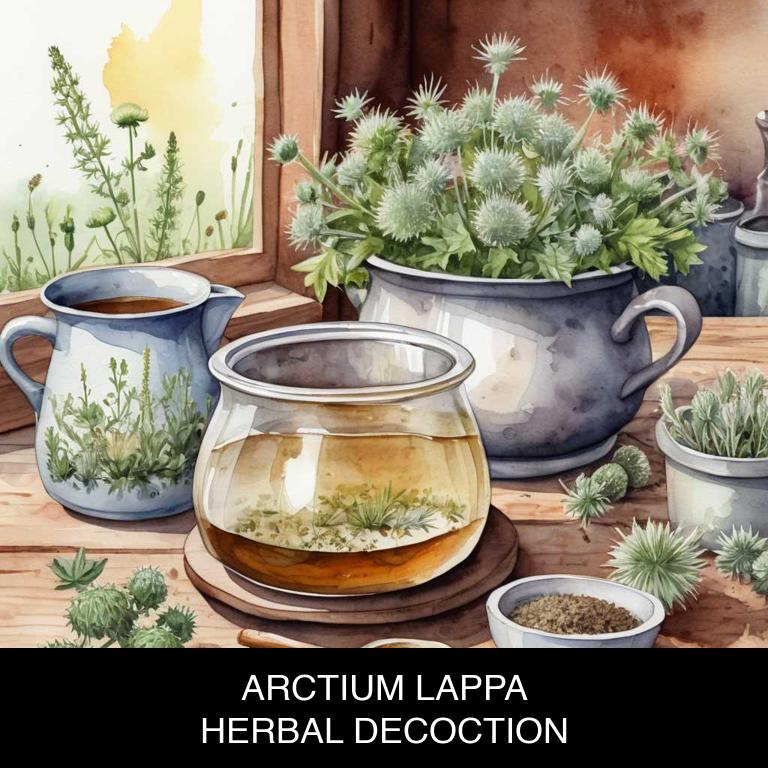
Medicinal Constituents
The list below shows the primary medicinal constituents in Arctium lappa decoctions that help with neck pain.
- Triterpenoids: These compounds have anti-inflammatory properties, which can help reduce swelling and pain associated with neck strain.
- Phenolic acids: These antioxidants can help reduce oxidative stress and inflammation in the neck muscles, promoting relaxation and pain relief.
- Alkaloids: Berberine has anti-inflammatory and analgesic properties, which may help alleviate pain and discomfort in the neck and surrounding areas.
Parts Used
The list below shows the primary parts of burdock used to make decoctions for neck pain.
- Roots: Roots are commonly used due to their high concentration of inulin, which has anti-inflammatory properties that can help reduce pain and swelling in the neck.
- Seeds: Seeds are used for their anti-inflammatory and analgesic properties, which can help alleviate neck pain and stiffness.
- Leaves: Leaves are used for their antioxidant and anti-inflammatory properties, which can help reduce pain, inflammation, and stiffness in the neck.
Quick Recipe
The following recipe gives a procedure to make a basic burdock for neck pain.
- Gather 2-3 grams of dried roots of the herb to be used for decoction.
- Rinse the dried roots with cold water and remove any impurities.
- Combine the dried roots with 250 milliliters of water in a saucepan.
- Bring the mixture to a boil then reduce heat and simmer for 10-15 minutes.
- Strain the liquid through a cheesecloth or a fine-mesh sieve into a cup.
5. Curcuma longa
Turmeric decoctions helps with neck pain because of its potent anti-inflammatory and antioxidant properties.
Curcumin, a compound found in turmeric, reduces inflammation that can cause pain and stiffness in the neck muscles and joints. The decoction also contains other beneficial compounds like gingerols and terpenes, which relax tense muscles, reduce swelling, and improve blood circulation.
As a result, regular consumption of turmeric decoctions can provide relief from chronic neck pain, promoting flexibility, comfort, and overall well-being.
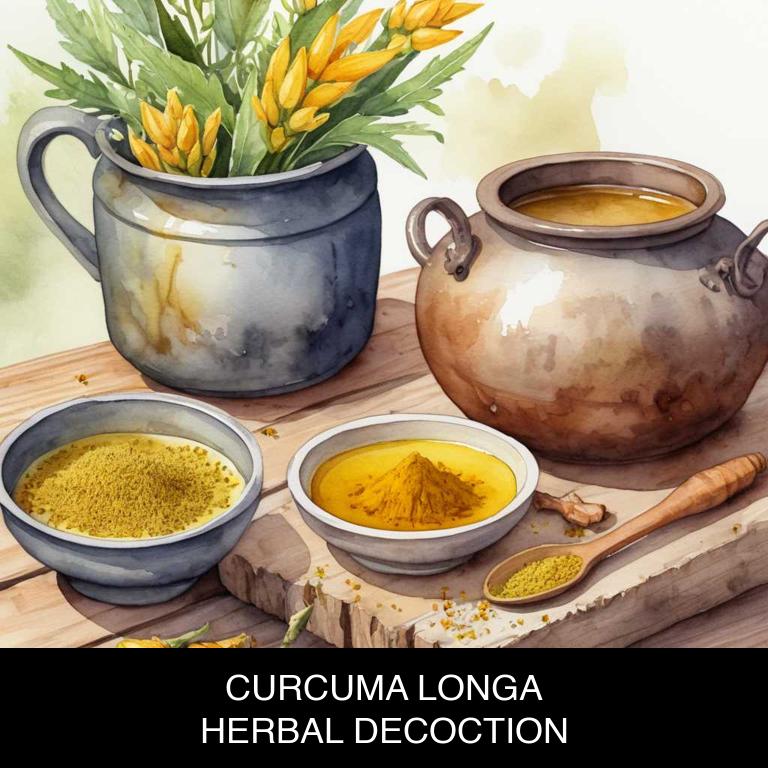
Medicinal Constituents
The list below shows the primary medicinal constituents in Curcuma longa decoctions that help with neck pain.
- Curcumin: Curcumin helps with neck pain by reducing inflammation and modulating pain pathways, which in turn alleviates discomfort and stiffness associated with neck pain.
- Demethoxycurcumin: DMC has potent anti-inflammatory properties, which help to reduce inflammation and swelling in the neck, thereby providing relief from pain and discomfort.
- Turmerone: Turmerone has neuroprotective and anti-inflammatory effects, which help to reduce oxidative stress and inflammation in the neck, leading to improved pain management and reduced discomfort.
Parts Used
The list below shows the primary parts of turmeric used to make decoctions for neck pain.
- Rhyzomes: Curcuma longa rhyzomes contain high concentrations of curcumin, a powerful anti-inflammatory compound that helps alleviate neck pain.
- Roots: Curcuma longa roots are rich in antioxidants and have anti-inflammatory properties, which aid in reducing neck pain and inflammation.
- Leaves: Curcuma longa leaves have analgesic and anti-inflammatory properties, making them effective in relieving neck pain and stiffness.
Quick Recipe
The following recipe gives a procedure to make a basic turmeric for neck pain.
- Gather 1 teaspoon of dried curcuma longa roots and 2 cups of water for the decoction.
- Boil the water in a saucepan for 5 minutes to create a rolling boil.
- Add the dried curcuma longa roots to the boiling water and reduce heat to a simmer.
- Allow the mixture to steep for 10 minutes to release the active compounds from the roots.
- Strain the decoction into a cup and discard the solids after the preparation is complete.
6. Zingiber officinale
Ginger decoctions helps with neck pain because of its anti-inflammatory properties, which can help to reduce swelling and alleviate stiffness in the affected area.
The warm liquid can also increase blood flow to the muscles, relaxing tense tissues and reducing muscle spasms that may be contributing to the discomfort.
Additionally, ginger has natural pain-relieving compounds called gingerols and shogaols, which have been shown to have analgesic effects, providing welcome relief from neck pain.

Medicinal Constituents
The list below shows the primary medicinal constituents in Zingiber officinale decoctions that help with neck pain.
- Gingerols: These compounds, particularly gingerol, possess anti-inflammatory properties that help reduce pain and inflammation in the neck, thereby alleviating neck pain.
- Shogaols: Similar to gingerols, shogaols exhibit potent anti-inflammatory and analgesic properties, which contribute to the relief of neck pain.
- Curcuminoids: Present in smaller amounts in ginger, curcuminoids have potent anti-inflammatory and antioxidant properties that help reduce oxidative stress and inflammation in the neck, ultimately alleviating neck pain.
Parts Used
The list below shows the primary parts of ginger used to make decoctions for neck pain.
- Rhyzomes: Rhyzomes are the most commonly used part of Zingiber officinale due to their high concentration of compounds like gingerol and shogaol, which have anti-inflammatory and pain-relieving properties.
- Roots: Roots are also used as an alternative to rhyzomes, containing similar compounds that help to reduce pain and inflammation in the neck.
- Barks: Barks of the Zingiber officinale plant are sometimes used in decoctions for their anti-inflammatory properties, which help to alleviate neck pain and stiffness.
Quick Recipe
The following recipe gives a procedure to make a basic ginger for neck pain.
- Harvest 2-3 inches of fresh rhizomes from a healthy zingiber officinale plant for a 1-cup decoction.
- Wash the harvested rhizomes under cold running water to remove any dirt or debris.
- Slice the cleaned rhizomes into thin pieces using a sharp knife or a grater for easier infusion.
- Combine the sliced rhizomes with 4 cups of water in a medium-sized pot and bring to a boil.
- Simmer the decoction for 5-7 minutes or until the liquid has reduced slightly and the flavors have melded together.
7. Angelica archangelica
Angelica decoctions helps with neck pain because of its natural anti-inflammatory properties, which soothe and relax tense muscles.
The herb's flavonoids and terpenes work together to reduce inflammation and pain in the neck and shoulder region, providing relief from stiffness and strain. Additionally, angelica's sedative qualities can help calm nervous tension that may be contributing to muscle spasms and discomfort, allowing for a more relaxing and rejuvenating experience.
As a result, angelica decoctions offer a natural and gentle solution for managing neck pain.
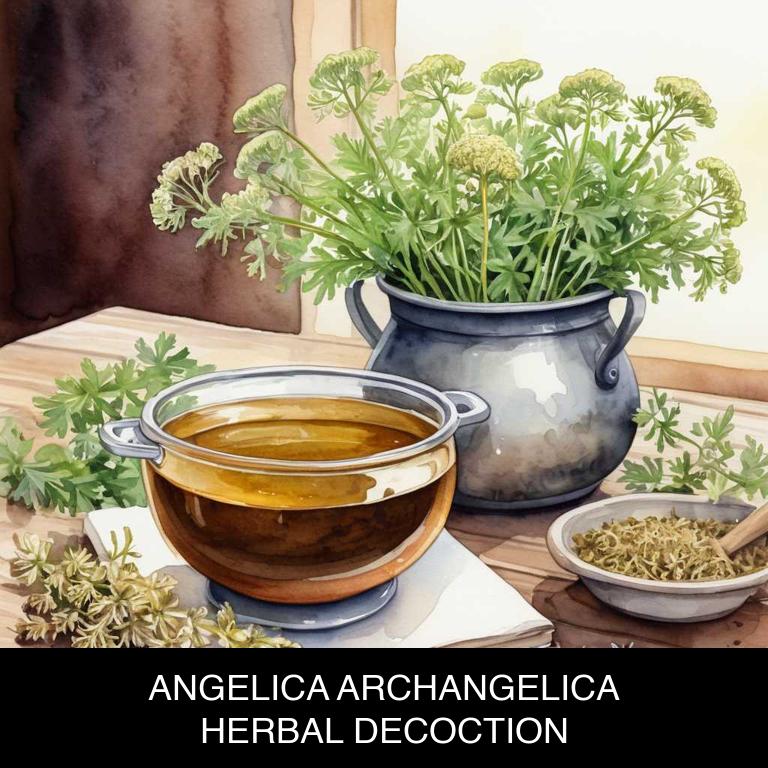
Medicinal Constituents
The list below shows the primary medicinal constituents in Angelica archangelica decoctions that help with neck pain.
- Phenolic glycosides: These compounds have anti-inflammatory properties, which help reduce pain and swelling in the neck, thereby alleviating neck pain.
- Angelica acid: This compound has analgesic and anti-inflammatory properties, which help relieve pain and reduce inflammation in the neck, making it an effective remedy for neck pain.
- Essential oil of angelica: The essential oil's analgesic, anti-inflammatory, and antispasmodic properties help relax neck muscles, reduce pain, and improve blood flow, which contributes to pain relief and reduced neck tension.
Parts Used
The list below shows the primary parts of angelica used to make decoctions for neck pain.
- Roots: Rich in essential oils and glycosides, which provide anti-inflammatory and analgesic properties to alleviate neck pain.
- Leaves: High in flavonoids, which help to reduce inflammation and soothe muscle spasms associated with neck pain.
- Stems: Contain sesquiterpenes, which exhibit anti-inflammatory and pain-relieving properties that can help in neck pain management.
Quick Recipe
The following recipe gives a procedure to make a basic angelica for neck pain.
- Harvest clean and dry angelica archangelica roots and leaves in the summer or fall when they are at their peak potency.
- Chop 2-4 grams of dried angelica archangelica roots and leaves into small pieces to increase their surface area.
- Combine the chopped herb with 250ml of boiling water in a saucepan to create the decoction base.
- Simmer the mixture for 10-15 minutes to allow the bioactive compounds to infuse into the water.
- Strain the decoction through a cheesecloth or fine-mesh sieve into a clean container to remove the solids.
8. Capsicum annuum
Bell pepper decoctions helps with neck pain because of its anti-inflammatory properties, which help to reduce swelling and ease stiffness in the muscles.
The decoction's warming effect also increases blood flow to the affected area, promoting relaxation and reducing muscle spasms. Additionally, bell peppers are rich in antioxidants and vitamins that help to repair damaged tissue and promote overall health.
As a result, consuming bell pepper decoctions can provide natural relief from neck pain and stiffness, allowing for improved range of motion and reduced discomfort.
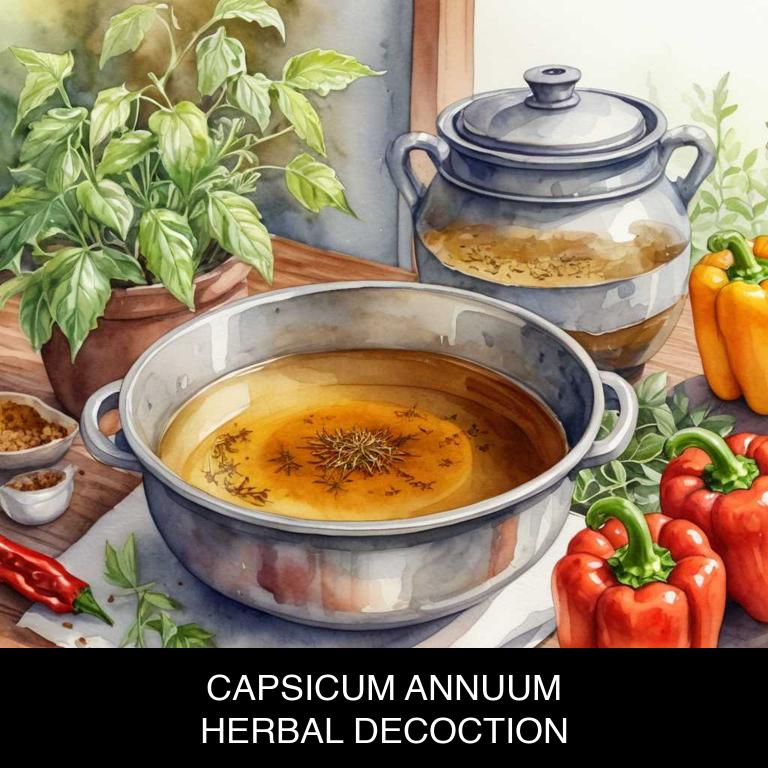
Medicinal Constituents
The list below shows the primary medicinal constituents in Capsicum annuum decoctions that help with neck pain.
- Capsaicin: Capsaicin is a potent analgesic and anti-inflammatory compound that helps alleviate neck pain by blocking the production of a chemical called substance P, which transmits pain signals to the brain.
- Quercetin: Quercetin is a flavonoid antioxidant that reduces inflammation and alleviates pain by inhibiting the activity of enzymes that contribute to inflammation and pain.
- Capsaicinoid glycosides: Capsaicinoid glycosides, such as dihydrocapsaicin and nordihydrocapsaicin, are responsible for the analgesic and anti-inflammatory effects of Capsicum annuum. They help with neck pain by reducing inflammation and blocking pain signals.
Parts Used
The list below shows the primary parts of bell pepper used to make decoctions for neck pain.
- Leaves: Capsicum annuum leaves are commonly used to make decoctions for neck pain due to their anti-inflammatory properties.
- Fruits (capsules): Capsicum annuum fruits, specifically their capsules, are used to make decoctions for neck pain due to their analgesic and anti-inflammatory effects.
- Seeds: Capsicum annuum seeds are used to make decoctions for neck pain due to their ability to provide relief from pain and reduce inflammation.
Quick Recipe
The following recipe gives a procedure to make a basic bell pepper for neck pain.
- Harvest 100 grams of fresh capsicum annuum fruit at the peak ripeness.
- Clean and chop the fresh capsicum annuum into small pieces weighing approximately 50 grams.
- Combine the chopped capsicum annuum with 1 liter of water in a saucepan.
- Boil the mixture for 15 minutes then reduce heat to simmer for 30 minutes.
- Strain the decoction through a cheesecloth or a fine-mesh sieve into a clean container.
9. Peucedanum ostruthium
Masterwort decoctions helps with neck pain because of its unique ability to reduce inflammation and relax tense muscles.
The decoction's active compounds, such as flavonoids and phenolic acids, have a natural analgesic effect that soothes stiff joints and reduces muscle spasms.
Additionally, masterwort's anti-inflammatory properties help to calm irritated tissues and improve blood flow to the affected area, promoting faster healing and relief from chronic neck pain.
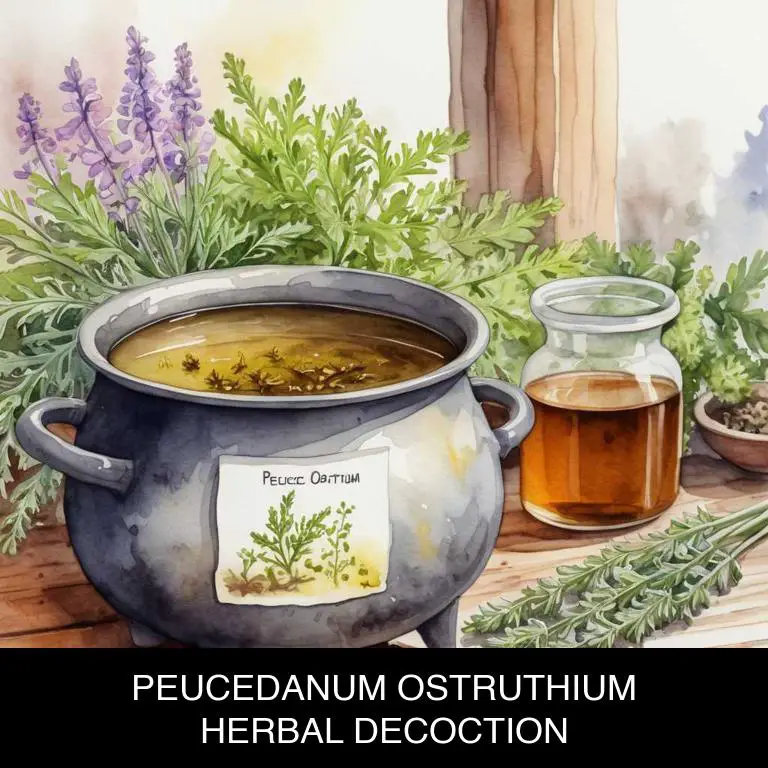
Medicinal Constituents
The list below shows the primary medicinal constituents in Peucedanum ostruthium decoctions that help with neck pain.
- Coumarins: These compounds have anti-inflammatory and antispasmodic properties, which can help to reduce muscle tension and inflammation in the neck, thereby alleviating pain.
- Phenolic acids: These compounds have antioxidant and anti-inflammatory properties, which can help to reduce oxidative stress and inflammation in the neck, thereby alleviating pain and promoting healing.
- Lignans: These compounds have anti-inflammatory and antioxidant properties, which can help to reduce inflammation and oxidative stress in the neck, thereby alleviating pain and promoting healing.
Parts Used
The list below shows the primary parts of masterwort used to make decoctions for neck pain.
- Leaves: Used due to their anti-inflammatory and analgesic properties which help alleviate neck pain.
- Roots: Utilized for their ability to reduce inflammation and relax muscles, providing relief from neck discomfort.
- Barks: Employed for their anti-inflammatory and antispasmodic properties, which help ease muscle tension and pain in the neck.
Quick Recipe
The following recipe gives a procedure to make a basic masterwort for neck pain.
- Gather fresh peucedanum ostruthium roots weighing about 20 grams for decoction preparation.
- Crush the peucedanum ostruthium roots into smaller pieces using a mortar and pestle.
- Combine the crushed roots with 500 milliliters of water in a saucepan.
- Boil the mixture over medium heat for 10 to 15 minutes or until the liquid is reduced by half.
- Strain the decoction through a cheesecloth or a fine-mesh sieve into a clean container.
10. Artemisia absinthium
Wormwood decoctions helps with neck pain because it contains potent compounds like thujone and sesquiterpenes, which exhibit anti-inflammatory and analgesic properties.
When consumed as a decoction, these bioactive molecules are absorbed into the bloodstream, targeting areas of inflammation and tension in the neck muscles. The resulting relaxation of muscle fibers reduces stiffness and discomfort, providing relief from chronic pain and promoting overall well-being.
Regular use of wormwood decoctions can also help to improve range of motion and reduce scar tissue formation.
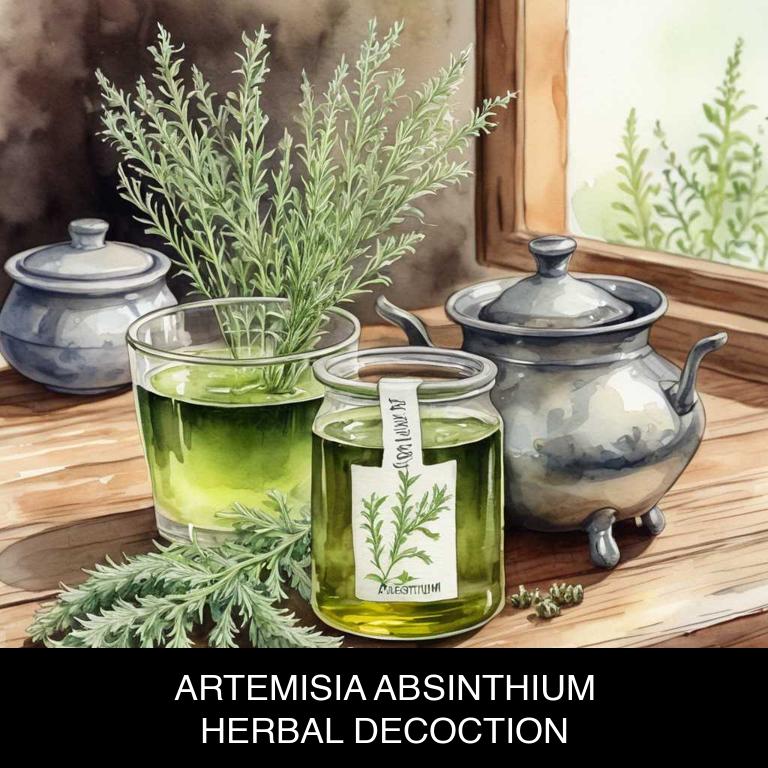
Medicinal Constituents
The list below shows the primary medicinal constituents in Artemisia absinthium decoctions that help with neck pain.
- Thujone: Thujone has analgesic and anti-inflammatory properties, which can help reduce pain and inflammation associated with neck pain.
- Absinthin: Absinthin exhibits anti-inflammatory and analgesic effects, which can help alleviate neck pain by reducing inflammation and pain perception.
- Artabsin: Artabsin has analgesic, anti-inflammatory, and antispasmodic properties, which can help relieve neck pain by reducing muscle spasms and inflammation.
Parts Used
The list below shows the primary parts of wormwood used to make decoctions for neck pain.
- Leaves: Used for their analgesic and anti-inflammatory properties, which help reduce pain and inflammation in the neck.
- Buds: Employed for their ability to reduce swelling and ease muscle tension, making them effective in relieving neck pain.
- Stems: Utilized for their antioxidant and anti-inflammatory properties, which help soothe and calm the neck muscles, reducing pain and discomfort.
Quick Recipe
The following recipe gives a procedure to make a basic wormwood for neck pain.
- Harvest fresh or dried artemisia absinthium leaves and flowers at dawn when the plant is at its highest concentration.
- Weigh 2-3 grams of the harvested material and place it in a clean glass container.
- Pour 100 milliliters of boiling water over the plant material and let it steep for 5-10 minutes.
- Strain the liquid through a cheesecloth or a fine-mesh sieve into another container.
- Store the decoction in the refrigerator and consume within 24 hours.
What is the best combination of herbal decoctions to use for neck pain?
The best combination of herbal decoctions that help with neck pain is a blend of Ginger, Turmeric, and Willow Bark.
Ginger has anti-inflammatory properties that reduce swelling and ease stiffness in the neck muscles. Turmeric contains curcumin, which has potent anti-inflammatory and antioxidant effects, helping to alleviate pain and inflammation. Willow Bark contains salicin, a natural pain reliever similar to aspirin, making it a natural choice to soothe neck pain and promote relaxation.
This trio can be brewed together as a tea or added to a warm bath for optimal relief.
What ailments similar to neck pain are treated with herbal decoctions?
Ailments similar to neck pain that are treated with herbal decoctions are conditions such as shoulder stiffness, lower back pain, and sciatica.
Herbal decoctions containing herbs like Turmeric, Ginger, and Boswellia can help alleviate inflammation, reduce pain, and improve joint mobility, making them effective remedies for these conditions.
Additionally, herbal decoctions may also be used to treat headaches, migraines, and menstrual cramps, which can radiate to the neck and shoulder areas.